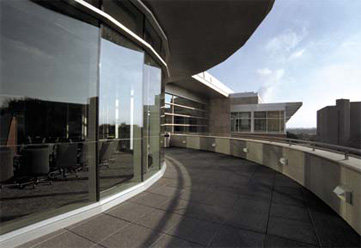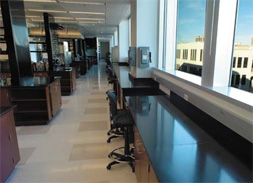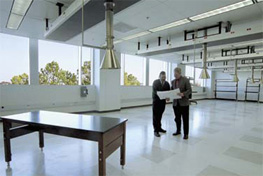Science at UT Arlington has entered a new world. Cutting-edge research requires the latest equipment and ample space to use it. Classes began there in January, but the public gets its first look at the Chemistry and Physics Building at a March 4 grand opening. The 123,678-square-foot facility boasts state-of-the-art teaching and research labs for chemistry, biochemistry and physics.
It houses the Center for Nanostructured Materials as well as a major grid computing center and collider detector construction facilities for the University’s internationally known High Energy Physics group. It is also home to a Digistar 3 planetarium that will provide virtual trips through the solar system and play an important role in educating science students from area school districts.
 |
| Looking east from the balcony above the planetarium provides a bird's-eye view of the Business Building. |
CHEMISTRY/BIOCHEMISTRY
Labs support research on cancer, polymers, semiconductors and more.
Edward Bellion believes that good things come to those who wait.
And wait.
And wait some more.
That conviction strengthened each time he passed the stock room in the oldest part of Science Hall and saw equipment being boxed for the recent move to the new Chemistry and Physics Building.
The building has been needed “for at least 25 years,” says Dr. Bellion, interim chair of the Department of Chemistry and Biochemistry and a UT Arlington faculty member since 1970.
To prove his point, he conducted a tour of the old labs where, when students plug in one piece of equipment, they must unplug another or a fuse will blow. They take turns running water because the drain cannot handle all the faucets at once. Rusted units on the floor supply heat and air conditioning; numerous leaks have left their mark on the ceilings below.
The W.A. Baker Chemistry Research Building, which opened in 1996, was phase one of a plan for the chemistry department, which has been hindered by a low-tech structure built long before the department offered graduate programs. The Baker building was a stopgap measure, Bellion said, to provide space for wet-chemistry research.
 |
| This spacious research area for chemistry is among the building's nearly 70,000 square feet of lab space. |
Phase two was supposed to be a six-story building for the rest of the department’s operations—classrooms, offices and research labs—but it was put on hold because of funding shortfalls and ultimately was canceled.
Finally, a new research and laboratory teaching building is a reality. In addition to providing 13 state-of-the-art labs for undergraduate classes, it includes space needed to attract competitive research grants. The facility will be a plus in recruiting faculty to train future students as physicians, nurses, chemists, pharmacists, engineers, biologists and material scientists.
Research, funded in part by grants from the National Institutes of Health, Department of Energy, U.S. Air Force, the Welch Foundation, the state of Texas and private industrial funds, soon will be under way in the new building, including:
- Sanjay Awasthi’s focus on developing antidotes for poisoning from harmful chemicals, as well as radiation, through studies of the enzymes necessary for glutathione to function optimally as a defense. Delivering these antidotes using nanoparticle technology is the goal.
- Bellion’s studies of the biochemistry of microbial growth on one-carbon compounds. This has potential applications for producing various chemicals and proteins using inexpensive start materials.
- Subhrangsu Mandal’s research on the mechanism of human gene regulation associated with cancer, especially acute myeloid and lymphoid leukemia in children and adults.
- Dennis Marynick’s “chemistry without chemicals,” using the laws of quantum mechanics and the University’s high-performance computing powers to model chemical reactions computationally, eliminating the need to actually synthesize the molecules.
- Zoltan Schelly’s studies of the behavior of artificial cell walls under high-voltage electric fields and employing the findings to create the smallest semiconductor and metal particles in the world. These quantum dots measure less than a thousandth of a millionth of an inch and have optical and electronic properties.
- Kevin Schug’s projects aimed at mimicking interactions in the body to study disease-related processes, such as cancer, and developing new analytical methodology to analyze pharmaceutical-type molecules.
- Richard Timmons’ use of plasma-enhanced chemical vapor depositions to create compositionally controlled thin polymer films. Current applications include improving the biocompatibility of biomaterials, developing better catalysts and generating novel dielectric films for use in electronic devices.
PHYSICS
Facilities include computing grid, clean room and machine shop.
 |
| Physics Professor Alexander Weiss and department Chair James Horwitz examine plans for a research lab. |
The grand tour of the physics area of the Chemistry and Physics Building begins down on the “farm.” Only this farm is as similar to the one inhabited by Old MacDonald as a candle to a nuclear power plant.
“If you go to a chicken farm, you see lots and lots of chickens,” said Assistant Professor Jaehoon Yu. “Here we have a major grid computing center with lots and lots of computers—a computer farm.”
In addition to the computing cluster, located in a large climate-controlled and windowed area, the first floor houses a clean room, a detector building room and a High Energy Physics group area that includes large cooling facilities for the grid farm that’s at the heart of the new ATLAS Tier 2 computing and analysis center. The computer networks are connected to ATLAS, a giant microscope housed underground at the supercollider in Geneva. There’s also a specialized machine shop where physics research equipment is made.
|
About the building... Grand opening: March 4. For details, visit www.uta.edu/cos or www.uta.edu/planetarium. Cost: slightly less than $43 million Square feet: 123,678 Location: East of the W.A. Baker Chemistry Research Building. A skybridge connects the structures. Number of workers: “A cast of thousands,” says UT Arlington architect John Guelian. Construction time: 21 months Research labs: The building features approximately 69,000 square feet of lab space, including labs for quantitative chemistry, plasma research, nanolayers and nanostructured materials. Shared space: Common areas on each floor promote interdisciplinary dialogue between the Chemistry and Physics departments. Organization by floor: Freshman teaching on one; upper-level teaching and research on two; graduate student and professor research as well as faculty offices on three. Rounded exterior: The letters that spell out the University’s name are water-jet cut. Each stone panel is 2 feet, 8 inches tall and 5 feet, 4 inches wide and weighs 300-400 pounds. Special flooring: The High Energy Physics detector construction room and main shop have a five-ton trolley crane; several milling, finishing and polishing machines; and a four-ton forklift. All rest on an eight-inch “floating” concrete floor completely isolated two inches above the main slab by a series of vibration isolation springs. “In the event that something really, really heavy is being moved, the resulting vibrations will not migrate through the building structure and interfere with other research labs and documentation,” says Sean Garman of Perkins + Will. Planetarium projection system: The planetarium is one of three in the country using the most advanced all-digital projection system, Digistar 3. It features six digital projectors arranged around the dome, instead of one central camera in the middle. Atrium: The three-story, skylit atrium offers open study areas and places to gather along the balconies and stairs. |
Up one floor, the labs and offices of Professor Alexander Weiss are involved in positron studies of surfaces, as well as a variety of other condensed matter/nanomaterials investigations.
Other faculty on this floor—Manfred Cuntz, Zdzislaw Musielak, Qiming Zhang, Nail Fazleev, Yi-Jiun Su and department Chair James Horwitz—perform theoretical/simulation/data analysis. The investigational range is broad: studies of white dwarf oscillations, fullerenes, interactions of positrons with surfaces, and ionospheric plasma transport through the magnetosphere, a region surrounding Earth that extends from 500 to several thousand kilometers above the surface. Charged particles are trapped in this region, and their behavior is dominated by Earth’s magnetic field.
Other research aims even higher. The scientists are studying the aurora on Jupiter and potentially habitable planets orbiting distant stars.
While most physics research sounds lofty to the non-scientist, such exploration has led to life-enhancing discoveries such as microwave ovens, television screens, computer laptops and x-ray diagnostics.
Research activities in the new building are supported by various federal and state agencies, including the National Science Foundation, Department of Energy, Air Force, Office of Naval Research, Welch Foundation and NASA.
PLANETARIUM
Transporting patrons out of this world.
The University’s state-of-the-art planetarium, opening March 4, is a 60-foot domed theater seating 165 stargazers and boasting a digital projection system that takes you there better than a Saturn rocket.
“Digistar 3 was designed to preserve all the classic planetarium functions while adding a wealth of new capabilities and features,” said E&S Digital Theater Vice President and General Manager Kirk Johnson. “It provides full-dome video playback, real-time 3D computer graphics and a sophisticated real-time 3D digital astronomy package. Users have access to all of these features simultaneously, so that real-time graphics can be seamlessly combined with full-dome video playback.”
The technology-rich system—fewer than two dozen exist nationwide—not only simulates stars and planets as seen from Earth, but it enables virtual trips through the galaxy. The planetarium’s first show, “The Stars at Night are Big and Bright!,” which runs through Sept. 1, includes a virtual journey into space.
“We will leave the friendly confines of the planetarium to travel to the edge of the known universe,” said planetarium Director Robert Bonadurer. “Along the way, we will visit the planets in our galaxy and explore exotic objects like black holes.”
Bonadurer is nationally known for his inventive shows geared to specific audiences. The planetarium’s first-year offerings range from one for preschoolers, “Star Light, Star Bright,” with songs and stories, to the date-friendly Valentine’s show, “Romancing the Stars.”
 |
| The building's rounded contour extends to the inside and houses a 165-seat, 60-foot domed planetarium. |
“This show is designed for couples,” Bonadurer said of the Valentine’s offering. “It visits the key ‘love’ constellations and shows how the night sky, celebrated in the arts, inspires love.”
If that inspiration is strong enough, couples can even be married in the planetarium, which will be available for weddings, birthday parties and other events. The facility also will work with academic departments like art, history, biology and geology to develop specialized shows for their curriculum.
Patrons can “buy” planetarium chairs and have a special loved one or a favorite professor honored with a permanent plaque, inscribed with up to two lines of 28 characters each. The price is $1,000, and the money raised goes into a planetarium endowment.
For information on staking a claim to part of this new campus and community attraction, contact the Office of Development at 817-272-2584 or visit www.uta.edu/giving.
— Sue Stevens
| Archives
| Alumni Association |
Giving to UTA | UTA
Home Copyright © 2006 UTA Magazine. All rights reserved. |
